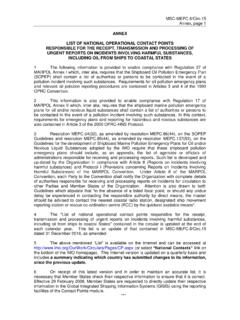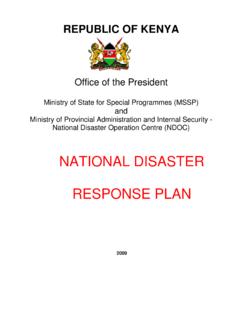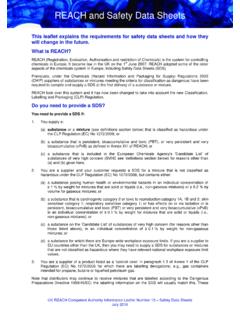Transcription of HEPATITIS B SURFACE ANTIGEN ASSAYS: …
1 WHO/BCT/ : GeneralOrig.: EnglishHEPATITIS B SURFACE ANTIGEN ASSAYS: OPERATIONALCHARACTERISTICS(PHASE I)REPORT 1 MAY 2001 BLOOD SAFETY AND CLINICAL TECHNOLOGYWORLD HEALTH ORGANIZATIONGENEVAC opyright World Health Organization, 2001 This document is issued by WHO for general document is not a formal publication of the World Health Organization (WHO), and all rights are reserved bythe Organization. This document may not be reproduced, in part or in whole, without written approval from thecontact person listed below. This document must not be used in conjunction with commercial or WHO nor the Central Public Health Laboratory, London, UK warrant or represent that the evaluationsconducted with the HEPATITIS B test kits referred to in this document are accurate, complete and/or error-free. WHO and the Central Public Health Laboratory disclaim all responsibility and liability for any use made of thedata contained mention of specific companies and of certain manufacturers products does not imply that they are endorsedor recommended by WHO in preference to others of a similar nature that are not : Dr.
2 G. Vercauteren, Blood Safety and Clinical Technology WHO 20, Avenue Appia 1211 Geneva 27 B SURFACE ANTIGEN ASSAYS: operational characteristics (PHASE I) information aspects of HBsAg testing brief and methods (test kits) WHO HBsAg Seroconversion Performance Sensitivity, specificity, confidence limits (CL) and predictive values of HBsAg Inter-reader Sensitivity in seroconversion Sensitivity in performance Additional analyses115. assay evaluations 12 Group 1: Simple/rapid assays14 Table characteristics and operational aspects14 Table of the results of assays with reference tests15 Table operational aspects16 Table 3.
3 (cont.) Detailed operational aspects17 Table s appraisal of the test kit18 Table of ease of performance19 Table for use in small laboratories20 Table on seroconversion panels21 Table on low titre performance panel22 Group 2: Simple/rapid assays23 Table characteristics and operational aspects23 Table of the results of assays with reference tests24 Table operational aspects25 Table 10.(cont.) Detailed operational aspects26 Table s appraisal of the test kit27 Table of ease of performance28 Table for use in small laboratories29 Table on seroconversion panels30 Table on low titre performance panel31 Explanatory notes for Tables 1-14 and Figures 1 and 232 Figure 1. Relative performance in seroconversion panels as compared to the reference assay (Monolisa Ag HBs Plus)35 Figure 2. Relative performance in seroconversion and low titre 37 Annex 1.
4 Algorithm for characterization of the WHO HBsAg panel37 Annex 2. Cumulative list of assays evaluated; currently commercially available38 Annex 3. Cumulative list of assay manufacturers Reading 41 WHO/BCT/ 1998, WHO implemented a programme for the evaluation of performance and major operationalcharacteristics of commercially available assays for the detection of HEPATITIS B SURFACE ANTIGEN (HBsAg). This first report presents the findings of the Phase I evaluations of 10 HBsAg assaysconducted during September to November 1999 and January to May 2001. The HBsAg assaysevaluated included:Group 1: Tables 1 7 ADVANCED QUALITY One Step HBsAg Test (Bionike Inc.) Determine HBsAg (Abbott Laboratories) Doublecheck HBs ANTIGEN (Orgenics) Genelabs Diagnostics Rapid HBsAg Test (Genelabs Diagnostics Pte Ltd.)
5 HEPACARD ( & Co. Ltd.)Group 2: Tables 8-14 ImmunoComb II HBsAg 90 (Orgenics) SERODIA (Fujirebio Inc.) Uni-Gold HBsAg (Trinity Biotech plc) GENEDIA HBsAg Rapid Device (Green Cross Life Science Corp) HEP B STAT-PAK ULTRA FAST (Chembio Diagnostic Systems Inc.)Section 2 of this report provides background information on the evaluations and the intended use ofthe evaluation results. Sections 3 and 4 present the laboratory aspects of HBsAg testing anddescribe the way in which the evaluations were conducted and the results analysed. The results andoutcomes of the analyses of the assay evaluations are contained in the tables and figures in section 5. Annexes 1, 2 and 3 show respectively, the algorithm for characterization of WHO HBsAg panel,the cumulative list of assays evaluated and the addresses of manufacturers of the assays first report contains Phase I assessments of simple/rapid tests only. Subsequent reports will beissued on a regular basis and will include results on enzyme linked immunosorbent assays (ELISAs)and assays using other technologies.
6 Copies of these reports are available on request from theDepartment of Blood Safety and Clinical Technology (BCT), World Health Organization, 1211 Geneva 27, INFORMATIONIn 1998, the World Health Organization (WHO) Blood Safety and Clinical Technology Department,conscious of the need to advise Member States on laboratory aspects associated with HEPATITIS Band HEPATITIS C testing for blood transfusion safety, initiated a project to provide objectiveassessments of commercially available assays for detection of HEPATITIS B SURFACE ANTIGEN (HBsAg)and HEPATITIS C (HCV) antibodies, similar to that which has existed for HIV since 1988. Thiscontinuing project is coordinated by the Department of Blood Safety and Clinical Technology,WHO; the WHO Collaborating Centre on Transfusion Transmissible Infections, SexuallyTransmitted and Blood Borne Virus Laboratory (SBVL), Virus Reference Division, Central PublicHealth Laboratories, London, UK carries out the laboratory investigations.
7 The aim of the project isto supply those responsible for deciding which tests to use, and potential users of tests, with enoughcomparative data to apply their own criteria and choose the best tests for their particular is intended that the evaluations will be conducted in two phases, the first using a limited panel ofwell characterized specimens held at the WHO Collaborating Centre (reference laboratory), thesecond in 3-4 field laboratories. Aliquots of the specimens used in the field evaluations will be sentto the reference laboratory for characterization. The purpose of this 2-phase approach is to expandthe number, type and origin of specimens in the evaluation panels and to archive them for use infuture assessments focus on the operational characteristics of these assays, such as ease ofperformance and their sensitivity and specificity on a panel of well-characterized sera of diversegeographical origins, and indicate their suitability for use in small laboratories, many blood-collection centres in developing countries.
8 In addition, the sensitivity of the assays onseroconversion and low titre specimens is being assessed. The findings of the assessments are published in the form of reports which are intended for use byhealth policy-makers, directors of blood banks, and managers of national prevention andsurveillance programmes. They may be used in conjunction with consideration of other factors, suchas experience with a given test, availability, cost, service and trouble-shooting provided locally bymanufacturers, to help select assays appropriate to local ASPECTS OF HBsAg brief overviewHepatitis B virus is a partially double-stranded circular DNA virus and is a member of theHepadnaviridae family. The virus consists of a core capsid which contains viral DNA and this issurrounded by an envelope containing SURFACE ANTIGEN . The clinical course of an HBV infectionincludes an incubation period (generally 4 - 12 weeks), acute illness (2 weeks 3 months) andrecovery for individuals who resolve their infection.
9 Many HBV infections in adults are without theclassical symptoms of jaundice. Individuals in whom HBsAg is present in their blood for more thansix months are considered to be chronically infected with HBV. Serological profiles of acute andchronic HBV infections are presented in Figures A, B and C 3 Figure A: Acute HBV infectionFigure B: Chronic HBV infection (HBeAg positive)Figure C: Chronic HBV infection (HBeAg negative)The most commonly used diagnostic and blood screening markers sought is HEPATITIS B surfaceantigen (HBsAg). An individual positive for HBsAg is considered to be infected with HBV, and istherefore potentially infectious. Confirmation of a reactive HBsAg ELISA screening test is usuallydone by performing a neutralization test using a specific anti-HBs antiserum in the same screeningELISA. Where a simple/rapid HBsAg test is used and no neutralization reagents are available,confirmation of an acute or chronic infection for diagnostic purposes may be concluded usingsymptoms and appropriate monitoring tests.
10 Other HBV markers which can be used diagnosticallyto monitor an HBV infection include, HBeAg, IgM anti-HBc, total anti-HBc, anti-HBe and anti-WHO/BCT/ 4 HBs. The presence of HBeAg indicates an individual is of higher infectivity, and seroconversion toanti-HBe correlates with reduced infectivity. In an acute infection it suggests that the infected personis progressing towards resolving their infection. Individuals who have seroconverted from HBsAg toanti-HBs have resolved their infection and are immune to further HBV most widely used HBsAg screening tests are ELISAs as they are the most appropriate forscreening large numbers of specimens on a daily basis, as is the case in blood transfusion services inindustrialized countries. However, many blood transfusion services in resource limited countries onlyprocess limited numbers of specimens. Hence, individual tests would be more appropriate. Severalsimple, instrument and electricity-free screening tests have been developed including agglutination,immunofiltration (flow through) and immunochromatographic (lateral flow) membrane tests.
















